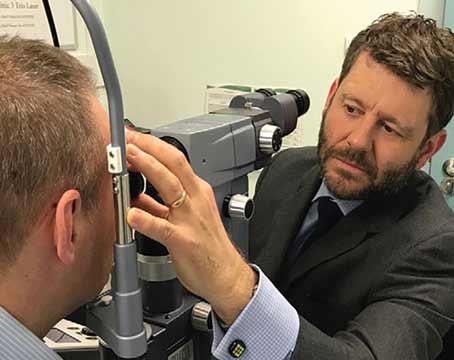As the data has come in from the recent large-scale clinical trials, it's become clear that lowering intraocular pressure plays a key role in preventing further glaucomatous optic nerve damage and visual field loss. The Advanced Glaucoma Intervention Study showed that higher IOP is associated with greater visual field progression,1 as did the Ocular Hypertension Treatment Study, which found that every extra millimeter of mercury correlated with greater risk of visual field progression.2,3 Further supportive data came from the Early Manifest Glaucoma Trial, in which every mmHg correlated with a 10-percent increase in risk of visual field progression.4 This knowledge gives us added motivation to continue treating a patient when our first treatment efforts fail to reach the IOP goal.
 |
In most situations, using medication as the initial treatment is the standard of care. And, if the first medication fails to lower pressure sufficiently, many of us would put the patient on an additional medication. But what about adding a third or fourth med? At what point does it make the most sense to resort to laser or surgery to lower IOP further?
The Downside of Adding Meds
Unfortunately, it appears that adding extra medications to your patient's regimen rapidly reaches a point of diminishing returns. Drawbacks to this approach include:
• Reduced efficacy. The most important issue is whether adding a third or fourth medication produces the desired result. A recent retrospective study of 96 patients found that, with success defined as lowering IOP at least 20 percent at one year, adding a third or fourth glaucoma drop only helped a small percentage of the patients.5 At six months, about 30 percent of patients using additional drops achieved the goal, but the success rate dropped to a dismal 14 percent at one year. (The class of drug that was added made no significant difference.)
• Poor compliance. This may be a big part of the reason for the less-than-impressive efficacy of added drops. In 1995 researchers interviewed 100 patients using multiple drops to determine compliance and reasons for non-compliance.6 They found that compliance decreased as the frequency of drops and number of meds increased. Fifty-one percent of patients using a drop one to two times a day admitted to poor compliance. That rose to 61 percent when drops were used more than two times a day. Among those taking multiple medications, non-compliance reached almost 70 percent.
The number one reason for this lack of compliance is forgetfulness, which isn't altogether surprising; most of these patients are elderly and have to remember to take many systemic medications. But several other factors, such as those listed below, also undermine compliance, contributing to the less-than-ideal efficacy of adding a third or fourth medication.
• Side effects. As you know, glaucoma medications have numerous local and systemic side effects:
• Prostaglandins can cause in-creased iris and skin pigmentation, as well as eyelash growth.
• Beta-blockers have cardiac and pulmonary side effects, and may cause depression and/or erectile dysfunction.
• Alpha-2 agonists can cause drowsiness and allergic reaction.
• Topical carbonic anhydrase inhibitors are often associated with local irritation.
• Use of cholinergics can produce miosis, induce myopia, and cause brow ache.
Adding more medications means subjecting the patient to more side effects. This is likely to increase patient unhappiness, undermine compliance and contribute to lowered efficacy of the prescribed meds.
| New Treatments on the Horizon |
| Many of the issues surrounding the debate over when to resort to surgery may be addressed by new alternatives that have recently become available or are in the pipeline: • Fixed combination drugs. With so many glaucoma patients using two or more glaucoma medications, pharmaceutical companies are eager to address the compliance issue by marketing combination drugs that minimize the number of drops the patient has to remember to take. Cosopt, which combines dorzolamide HCl and timolol maleate, is currently available. Three new combination drugs are under investigation: Extravan (travoprost 0.004% plus timolol 0.5%) from Alcon; Xalcom (latanoprost 0.005% plus timolol 0.5%) from Pfizer; and Combigan (brimonidine tartrate 0.2% plus timolol 0.5%) from Allergan. • Selective Laser Trabeculoplasty. SLT, which offers the benefits of argon laser trabeculoplasty without the irreversible damage that ALT causes, may avoid many of the complications of medications and surgical procedures. • Neuroprotective agents. Medications with the potential to protect the optic nerve from damage, such as memantine and statins, may soon provide an avenue of treatment for those patients whose pressures may not be low enough, or who progress despite very low pressures. • Safer filters. As newer setons and surgeries are developed, the problems associated with this option may eventually be minimized. • New surgical options. These could include non-penetrating surgeries. |
• Cost to the patient. As a result of the high cost of medicine that continues to plague our medical system, added medications mean an added burden for the patient. For some patients, it's an additional reason to forego compliance.
• Poorer surgical outcomes. A 1994 study provides yet another reason for not adding more medications. This study found that patients who had used more medications had a significantly decreased likelihood of a successful trabeculectomy.7 With success defined as a post-surgical IOP of 22 mmHg without the use of drops, researchers found:
• Patients using minimal or no meds had a trabeculectomy success rate of 93 percent.
• Patients who had used a beta-blocker only had a success rate of 90 percent.
• Patients using a beta-blocker and a miotic had a significantly lower success rate of 72 percent.
• Patients using three medications (beta-blockers, miotics and sympathomimetics) only had a success rate of 54 percent.
The Advantages of Medication
On the other hand, some evidence does support the approach of maximizing medication and avoiding surgery. For example, the Collaborative Initial Glaucoma Treatment Study, a large prospective National Institute of Health study, looked at the safety and efficacy of surgery vs. medication as initial treatment for newly diagnosed glaucoma.8,9 Although the data indicated that surgery produced more pressure reduction than medications did, some of the data from the study did favor the medical option:
• Adverse events. Patients undergoing surgery had a higher rate of cataract surgery in the four years after treatment than patients treated with drops.
• Visual acuity. Patients undergoing surgery had worse visual acuity in the early period following treatment, although this difference disappeared by the end of the study.
• Visual field. Although surgery had the advantage in terms of pressure reduction, both groups had almost identical visual field scores by the end of the study, suggesting that both medicine and surgery had equal efficacy in terms of visual outcome.
• Local symptoms and irritation. Patients treated with surgery reported more local side effects than patients using drops. Given that visual field changes were not significantly different at the end of the study, these results suggest that drops may be safer and more comfortable for the patient.
Making the Decision
In the final analysis, when is it time to resort to surgery? The answer probably should depend on the individual patient. Questions worth asking include:
• How much damage has already occurred?
• What is the patient's current IOP, and what is your goal? (Remember to account for central corneal thickness and diurnal pressure fluctuation.)
• How compliant is the patient likely to be?
• What is the patient's estimated life span?
• How does the patient's race figure into risk of progression? (For example, overall risk of progression is greater for African Americans.)
• What is the patient's tolerance for side effects? (Some patients absolutely refuse to use drops chronically.)
Once you've taken these factors into account, your experience and judgment should be the deciding factor. With multiple options available—and new ones on the horizon—we should be able to help the vast majority of our patients preserve their vision.
Dr. Lin is an assistant professor of ophthalmology on the Glaucoma Service at the University of California, San Francisco, and director of the Glaucoma Service at the San Francisco General Hospital.
1. The Advanced Glaucoma Intervention Study (AGIS): 7. The relationship between control of intraocular pressure and visual field deterioration. The AGIS Investigators. Am J Ophthalmol 200;130:4:429-440.
2. Gordon, MO, Beiser JA, Brandt JD, Heuer DK, Higginbotham EJ, Johnson CA, Keltner JL, Miller JP, Parrish RK II, Wilson MR, Gordon MO. The Ocular Hypertension Treatment Study: baseline factors that predict the onset of primary open-angle glaucoma. Arch Ophthalmol 2002;120:6:714-720.
3. Kass MA, Heuer DK, Higginbotham EJ, Johnson CA, Keltner JL, Miller JP, Parrish RK II, Wilson MR, Gordon, MO. The Ocular Hypertension Treatment Study: a randomized trial determines that topical ocular hypotensive medication delays or prevents the onset of primary open-angle glaucoma. Arch Ophthalmol 2002;120:6:701-13.
4. Leske MC, Heijl A, Hussein M, Bengtsson B, Hyman L, Komaroff E. for the Early Manifest Glaucoma Trial Group. Factors for glaucoma progression and the effect of treatment. Arch Ophthalmol 2003;121:48-56.
5. Neelakantan A, Vaishnav HD, Iyer SA, Sherwood MB. Is addition of a third or fourth antiglaucoma medication effective? J Glaucoma 2004;13:2:130-136.
6. Patel SC, Spaeth GL. Compliance in patients prescribed eyedrops for glaucoma. Ophthalmic Surg 1995;26:3:233-236.
7. Broadway DC, Grierson I, O'Brien C, Hitchings RA. Adverse effects of topical antiglaucoma medication. Arch Ophthalmol 1994;112:1446-54.
8. Lichter PR, Musch DC, Gillespie BW, Guire KE, Janz NK, Wren PA, Mills RP; the CIGTS study Group. Interim clinical outcomes in the Collaborative Initial Glaucoma Treatment Study comparing initial treatment randomized to medications or surgery. Ophthalmology 2001;108:11:1943-53.
9. Janz NK, Wren PA, Lichter PR, Musch DC, Gillespie BW, Guire KE, Mills RP, the CIGTS Study Group. The Collaborative Initial Glaucoma Treatment Study. Ophthalmology 2001;108:11:1954-1965.




